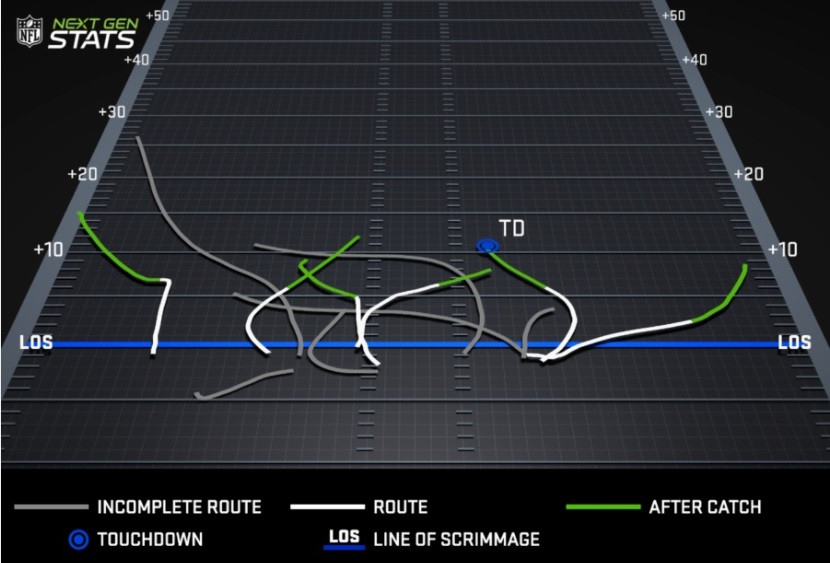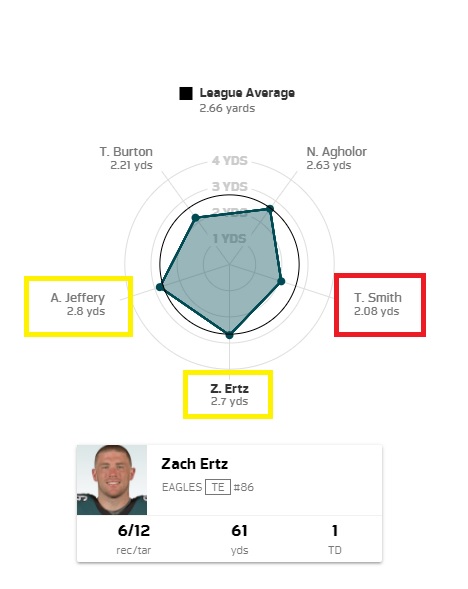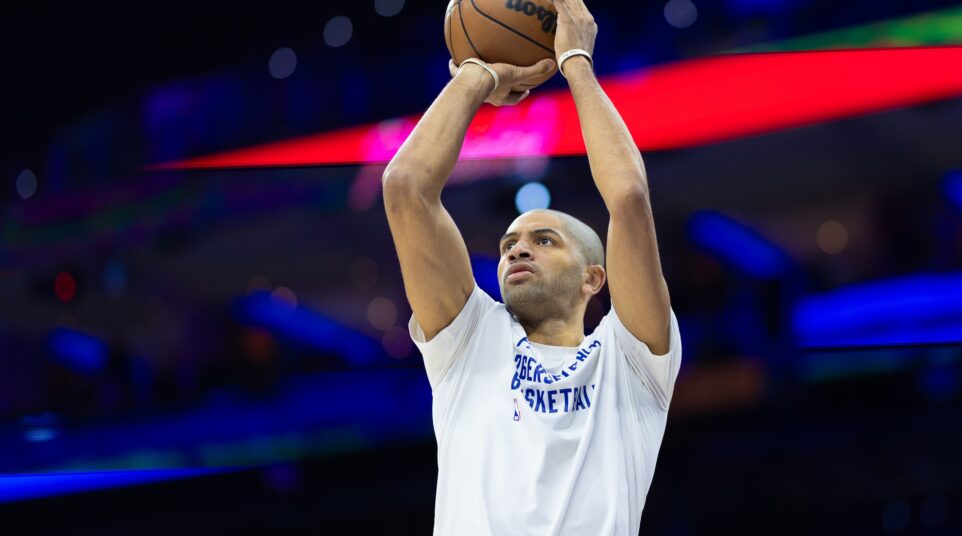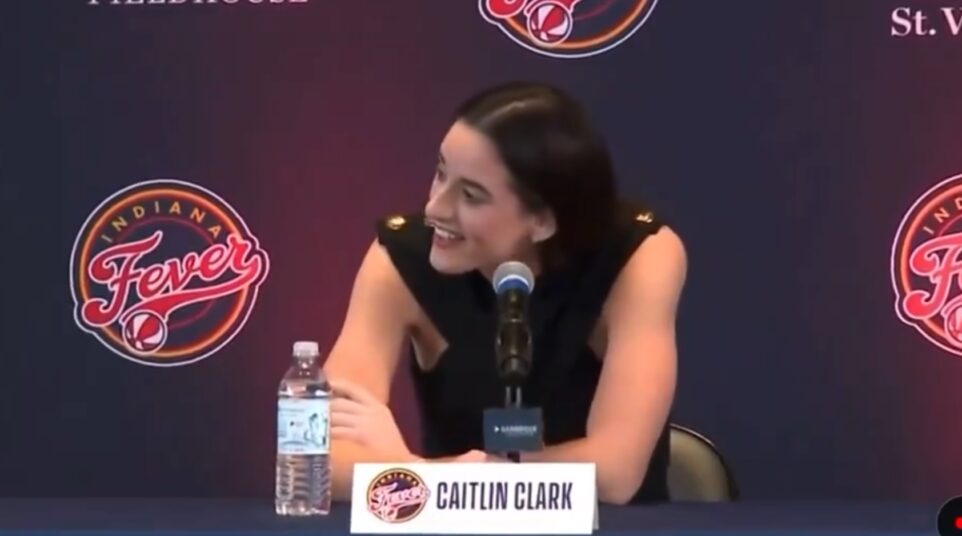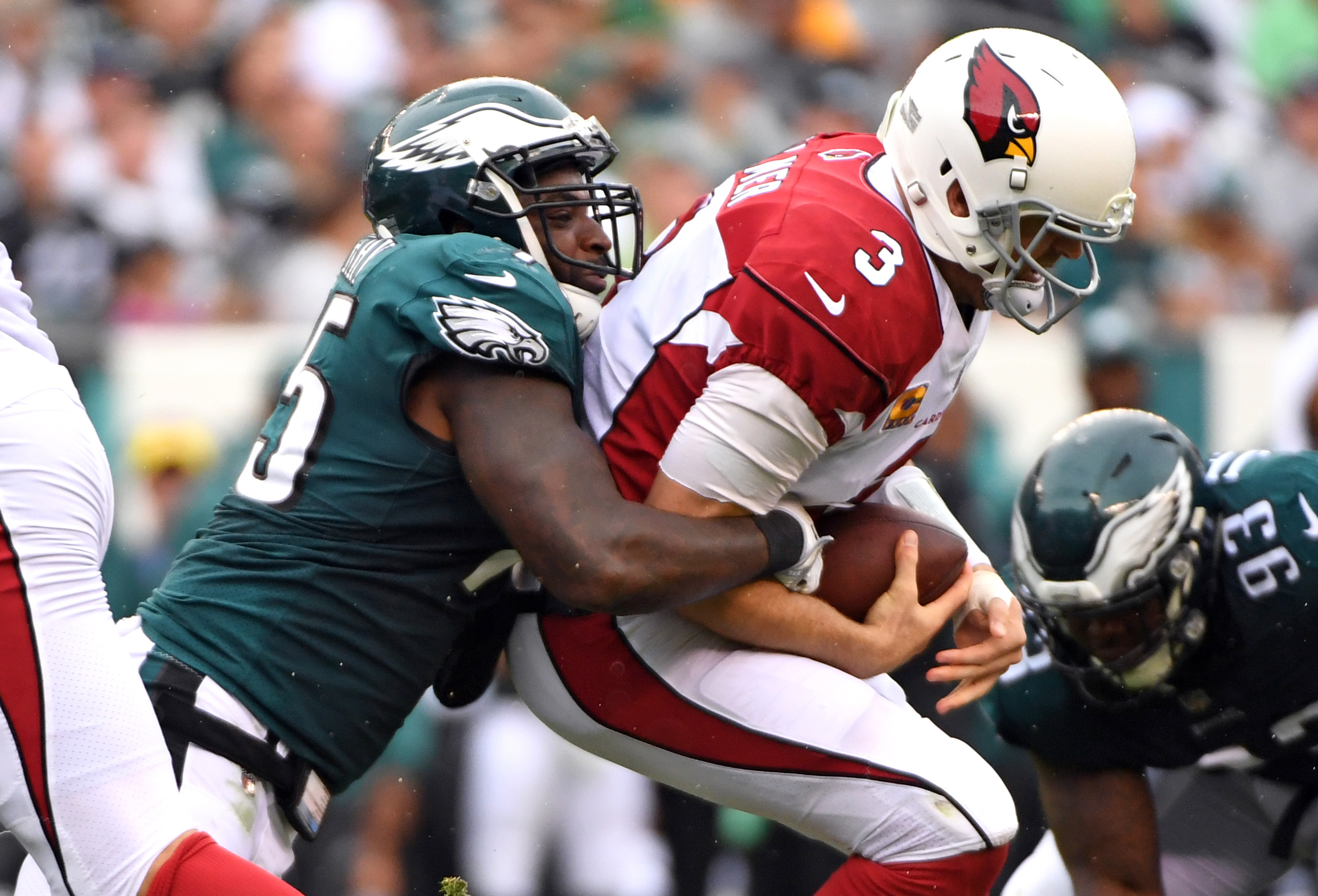
A Tale of Two Carsons: Ten Takeaways from Eagles 34, Cardinals 7
Let’s start with this: The Arizona Cardinals were garbage yesterday.
Now that we’ve established that, let’s dive into the thesaurus to find an accurate word describing the Eagles’ performance: Comprehensive? Commanding? Dominating? Domineering?
We’ll go with all of the above.
Your Philadelphia Eagles looked more like the ’85 Bears on Sunday afternoon, scoring early and often to complement a stifling defensive performance. They did it again without Fletcher Cox and Ronald Darby, holding the Cardinals to 33 rushing yards and forcing Carson Palmer to chuck it 44 times in a 27-point loss.
That’s what good teams do; they go out and drop the hammer on inferior opponents. This game didn’t feature the usual fourth quarter slump, and even though the Birds took their foot off the gas pedal, the outcome was never in doubt.
Next up is a monolithic, gigantic, uber-important matchup against Cam Newton and the Carolina Panthers, who just ripped off back-to-back road wins at New England and Detroit. A Thursday night Eagles victory should expunge the narrative that this team “hasn’t beaten anyone yet.”
1) No Smallwood, no problem
I wondered if the absence of Wendell Smallwood might change the way the Eagles ran the ball this week, but it really didn’t.
First, a bit of foreshadowing from Doug Pederson last Friday:
“We do have specific runs for guys, but all the guys have to know those specific runs. We do call for specific guys in certain situations, but listen, LeGarrette has to know them all, Corey has to know them all, Wendell has to know them all, even Kenjon Barner has to know them all. That’s kind of the way we approach that.”
That quote held up, as you saw the typical blend of under-center and shotgun running, with Corey Clement and Kenjon Barner taking a bit more of the east/west play calls that had been reserved for Smallwood and Darren Sproles in earlier weeks.
Pederson didn’t run the ball as much this week because he didn’t have to. The Birds’ passing game was clicking from the start and this iteration of the three-headed monster finished with 26 carries for 114 yards.
I actually thought we might see more of Clement, who ran it 10 times last week, but only handled it seven times Sunday. Blount ran it 14 times and Barner finished with five attempts.
It was basically a “plug and play” situation with Barner. He took this delayed hand off, which would normally go to Smallwood:
They also tried that stretch play a few times, which really hasn’t gone for much in previous weeks. They were stuffed once or twice in this game before Blount broke out with a big third quarter gain. This was one of their best runs of the day, with brilliant edge blocking:
Beautifully set edge and LeGarrette Blount is loose on the second level pic.twitter.com/q5GEtfachk
— Kansas More Chaints (@AdrianFedkiw) October 8, 2017
2) Sticking to the script
This season has been all about strong starts and poor finishes, but Week 5 featured the former without the latter.
The Eagles have scored points on the first drive in four out of five games for an 80% success rate. After Sunday, they’ve now outscored their opponents 41-3 in the first quarter.
A lot of that is due to the defense always being ready to play, but it also has something to do with Pederson’s scripting of the opening drive.
Here’s what Sunday’s first series looked like (10 plays, 54 yards, 5:26) –
- 1st and 10: incomplete pass
- 2nd and 10: five-yard completion
- 3rd and 5: Arizona neutral zone infraction, automatic first down
- 1st and 10: LeGarrette Blount six yard run
- 2nd and 4: Carson Wentz sacked for 7 yard loss
- 3rd and 11: 12 yard completion to Zach Ertz
- 1st and 10: incomplete pass
- 2nd and 10: rush for one yard loss
- 3rd and 11: 16 yard completion
- 1st and 10: 3 yard completion
- 2nd and 7: 15 yard touchdown pass
It wasn’t seamless execution, but the drive featured two third-and-long conversions and a Cardinals penalty to keep the Birds alive. The 3rd and 11 Zach Ertz toss was an example of the Eagles looking at four weeks of film and picking a bread-and-butter play to extend the drive (more on that later).
They’ve now scored 24 points on opening drives. Consider that the maximum amount of points you can score on five opening drives is 35 (five touchdowns with extra points, no two-point conversions), and the Eagles have claimed 68.5% percent of available points on the first drive of the game.
3) Let’s pick just one
I wrote last week about how one Eagles left guard is playing better than the other Eagles left guard.
Spoiler: It’s Stefen Wisniewski.
But this week we again got the Wisniewski and Chance Warmack rotation for whatever reason.
This is how it broke down:
- Drive 1: Wisniewski (touchdown)
- Drive 2: Wisniewski (touchdown)
- Drive 3: Wisniewski (touchdown)
- Drive 4: Warmack (punt)
- Drive 5: Warmack (punt)
- Drive 6: Wisniewski (interception)
- halftime
- Drive 7: Wisniewski (field goal)
- Drive 8: Wisniewski (touchdown)
- Drive 9: Wisniewski (punt)
- Drive 10: Warmack (field goal)
- Drive 11: Warmack (end of game)
They gave “Wis” more drives this week. Last time out, they rotated guards every two series.
I’d have to go back and watch the entire film again before coming up with a credible hot take here, but we’ve seen in past weeks that Wisniewski has been much more steady on the left side. If nothing else, the idea of keeping him there should help Jason Peters and Jason Kelce find continuity and consistency throughout the game, as opposed to having to readjust every couple of drives.
For what it’s worth, Warmack was called for holding on the Blount touchdown run in the second half.
Crazy how the Eagles’ offense hasn’t been as good since Chance Warmack was put in.
— Brandon Lee Gowton (@BrandonGowton) October 8, 2017
4) Ertz so good
Last week, the Birds had a lot of success finding Zach Ertz up the middle on play-action calls.
He did a lot of his damage up the gut again this week, with four of six catches taking place in the middle third of the field:
At 6’5″, 250 pounds, Ertz is a nightmare slot matchup.
Here he’s covered by a 6’0″, 200 pound safety. Ertz sheds coverage, snags the ball in stride, and gains five more yards after the catch for a huge third down conversion:
That’s tried and true Zach Ertz right there.
They’ve found him on that pattern so many times this year that they might as well move it to the part of the playbook that says, “use this one at least four times per game.”
5) Let’s create some separation
One stat that I think tells the story about this game is “wide receiver separation.”
Entering Week 5, Ertz was the 21st ranked tight-end in this category, with an average of 2.2 yards between him and the nearest defender during a passing attempt.
He finished this game with a 2.7 mark in this category:
You see that Ertz and Alshon Jeffery were both above the 2.66 league average. Torrey Smith was almost half a yard below it, despite the big touchdown catch and worthy celebration.
The obvious takeaway is that Ertz was able to push through contact at the line of scrimmage, which you saw from some of those looks down the middle (no duh). But the other thing to think about is that when you have a lower “SEP” number and you still dominate among tight ends in catches and yards, it means you’re making more tight-window grabs and securing the ball under pressure. (Think about Brent Celek and how he used to get hit immediately after catching the ball.)
It’s nice to have a high SEP number, but a ratio of low SEP to total catches also tells a very positive story.
6) The third phase of the game
This was probably the Eagles’ best all-around special teams performance of the season. I say “all-around” because Jake Elliott had a fantastic couple of weeks kicking field goals, but the coverage and return game was also very good on Sunday.
It started with Barner, who contributed 110 yards on three punt returns. His 76-yard effort was a big reason why the Eagles were able to jump out to a two-score lead. And even if you take away that gain, he averaged 17 yards on the other two returns.
Smartly, the Eagles purposefully kicked the ball short to pin Arizona inside their 20 yard line a few times in the first half.
This placement was designed:
Also, with the Cardinals forced to use their back-up long snapper, the Birds blocked a field goal before halftime as well. That was Patrick Robinson, who added three tackles and three pass breakups in an excellent performance.
If you tally it up, here are the special teams takeaways:
- blocked FG
- 76 yard punt return
- 18.5 average kick return yards for opponent
- 7-yard Arizona return on one punt
- Elliott 2/2 field goals (36 and 28 yards) and 4/4 XP
7) 99% good, 1% bad
Late in the second quarter, with a chance to bury the game, Carson Wentz was intercepted by Antoine Bethea in the end zone. That was probably his worst pass of the game and it came immediately after a dropped interception by Patrick Peterson on the other side of the field.
It was Wentz’s first turnover since Week 2. The Eagles are still +2 in turnover margin, however, and finished with a net of zero on Sunday due to a late Cardinals fumble that went out of the end zone.
The rest of the game, Wentz was outstanding, especially on third downs, where he went 11-of-12 for 229 yards and three touchdowns. His deep ball was on target and his touch was there as well, which you saw right off the bat with the slot fade TD pass for Trey Burton. He also did well to avoid the blitz on several occasions, particularly on the Nelson Agholor touchdown.
He doesn’t look like a second-year quarterback:
https://twitter.com/a2dradio_com/status/917105295951847425
8) Doug’s worst call?
There are usually a bunch of candidates, but not after this game. I guess I would say his worst decision is to continue with the left guard rotation.
Maybe some of those wide receiver flat passes and screens were kind of useless, but they do serve to set up vertical plays by forcing defenders to respect the east/west game. The Birds were certainly successfully throwing deep.
I crowd sourced for the rest:
9) Doug’s best call?
Pretty much 95% of his play calling.
Situationally, I thought he was smart to make Arizona punt it again at the end of the third quarter after a holding penalty. Considering what had happened on the previous punt (Barner’s huge return), It was another chance to get the ball in a skill player’s hands with field-flipping potential.
Otherwise:
10) Miscellaneous musings
Chris Myers sounded a little sleepy during this game, but the broadcast crew was okay I thought. They only confused their Carsons two or three times, which happens. The Kenyon “Burner” slip up was ironic and appropriate.
I went to the Guns N’ Roses show at “The Center” after the game, and while Axl didn’t mention the Eagles, he did mumble something about Wilt Chamberlain during the three-hour set (they were great and they changed up the setlist from last year’s tour).
The best part about the broadcast was not seeing the Hyundai “Sweet Caroline” commercial and the worst part was the fourth quarter cheesesteak mention. I thought we might make it through a whole game without a typical Philly cliche drop, like the Liberty Bell, Rocky Statue, Reading Terminal Market or Bruce Springsteen.
Behold, the worst song of all time:


